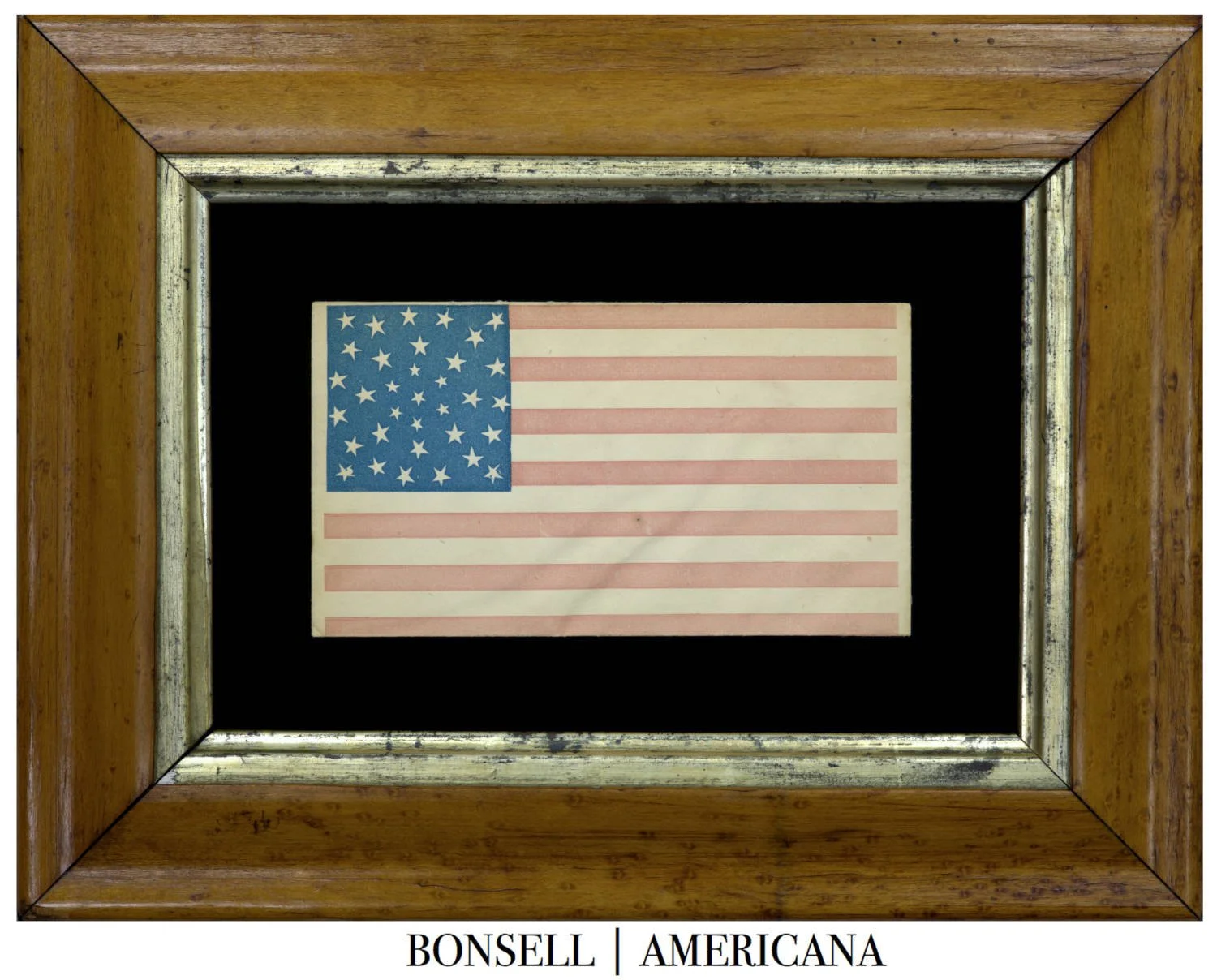13 Star Antique Yacht Flag | A Striking Example of American Maritime Heritage | Circa 1895-1926
13 Star Antique Yacht Flag | A Striking Example of American Maritime Heritage | Circa 1895-1926
Frame Size (H x L): 35” x 47”
Flag Size (H x L): 23” x 35”
Offered is flag identified as a private U.S. yacht ensign, traditionally used as a substitute for the standard U.S. national flag on private pleasure craft navigating U.S. waters. These flags feature a distinctive design with a canted anchor surrounded by a circular wreath of thirteen stars, symbolizing the original thirteen colonies. The use of the U.S. yacht ensign emerged from practical needs during an era when the federal government heavily relied on tariffs and customs duties for revenue, prior to the introduction of modern income tax laws.
As private yachting gained popularity among affluent Americans in the 19th century, customs officials frequently inspected yachts, which were seldom engaged in commerce. To streamline operations, Congress intervened in 1848 by officially designating the U.S. yacht ensign for use on registered private vessels. Once a vessel displayed the U.S. yacht ensign, it was exempted from routine customs inspections, allowing its owners uninterrupted leisure sailing.
The U.S. yacht ensign was never intended to replace the national ensign but was instead flown alongside it. Protocol dictated that the yacht ensign be flown from the masthead while the national ensign was displayed on the stern or gaff. However, due to its aesthetic appeal and practicality, many private vessels adopted the yacht ensign as their sole flag, a practice that, while non-compliant with maritime customs, became widespread among enthusiasts.
The law permitting the use of the U.S. yacht ensign remained in effect for over a century but was repealed in 1980. Despite this, the tradition of flying the yacht ensign persists, appreciated for its historical significance and elegance. Over time, the yacht ensign has become more than a maritime signal; it has evolved into a beloved emblem of nautical heritage, embodying the spirit of American yachting and pride in its unique design.
CONSTRUCTION
The canton and stripes are constructed from plain weave wool bunting, pieced together with treadle stitching—a common technique of the time. The wool stripes provided strength and durability, as wool was highly resistant to fraying and wear in maritime environments, making it ideal for flags exposed to wind, moisture, and sunlight.
A striking feature of this flag is the cotton anchor motif in the canton, which is unusually narrow and folksy in execution. This distinctive design enhances the flag’s desirability and visual appeal, setting it apart from other yacht flags of the era. The combination of high-quality materials and skilled craftsmanship reflects the practical demands of its time while contributing to its aesthetic and historical significance.
The stars, made of cotton, were double-appliqued to both sides of the canton using a zig-zag stitching technique. This method, indicative of flags made after 1895, ensured the stars were securely attached while adding a decorative element. The flag's overall construction and design suggest it was produced no later than 1926, situating it within a clear historical timeframe.
Reinforcing the flag is a twill cotton binding along the hoist, designed to ensure durability during use. It features two grommets, likely made of nickel-plated brass—a material valued for its strength and resistance to corrosion. While pure zinc grommets were occasionally used, they were less common due to their softness and lower durability. The nickel-plated brass grommets provide the silver appearance typically seen on high-quality flags.
THIRTEEN-STAR FLAGS GENERALLY
The origins of the thirteen-star flag trace back to June 14th, 1777, when the Continental Congress passed a resolution creating the first official U.S. flag. This design, symbolizing the unity and independence of the original thirteen colonies, served as the official flag from 1777 to 1795 but continued to hold symbolic significance in various capacities.
From 1795 to 1916, small U.S. Navy boats used the thirteen-star flag as their ensign, solidifying its role in America’s maritime traditions. It also featured prominently during significant moments of national mourning and celebration, such as George Washington’s death in 1799 and the 50th anniversary of American independence in 1824. Notably, the flag was central to celebrations honoring General Lafayette’s return to the U.S., reflecting deep gratitude for his contributions during the Revolutionary War.
During the Mexican-American War (1846–1848) and the Civil War (1861–1865), the thirteen-star flag became a cherished symbol of patriotism and unity. Its ties to the Revolution made it especially poignant during times of national struggle. The flag’s legacy was further cemented during the centennial celebrations of 1876, where it represented the enduring strength and progress of the United States.
Steeped in historical significance, the thirteen-star flag remains a powerful emblem of America’s origins and enduring heritage. Its use across centuries underscores its role as a symbol of unity, resilience, and celebration, making it one of the most iconic representations of the nation’s history.
Conservation Process: This flag was hand sewn to cotton fabric, and both were hand sewn to a mounting board. To prevent the black dye in the cotton fabric from seeping into the flag, it was first washed in a standard wash and then in a dye setting wash. The flag is positioned behind Optium Museum Acrylic.
Frame: This modern frame features a black finish with a subtle bevel, offering a clean and simple design.
Condition Report: This flag is in excellent structural condition, with intact stitching and durable materials. There is uniform yellowing throughout, consistent with natural aging, along with a slightly darker yellow area to the right of the canton. The imperfections add to the flag’s character.
Collectability Level: The Great – Perfect for Rising Collectors
Date of Origin: 1895-1926
Number of Stars: 13
Associated War: World War I (1914-1918)
Associated State: Original 13 Colonies











